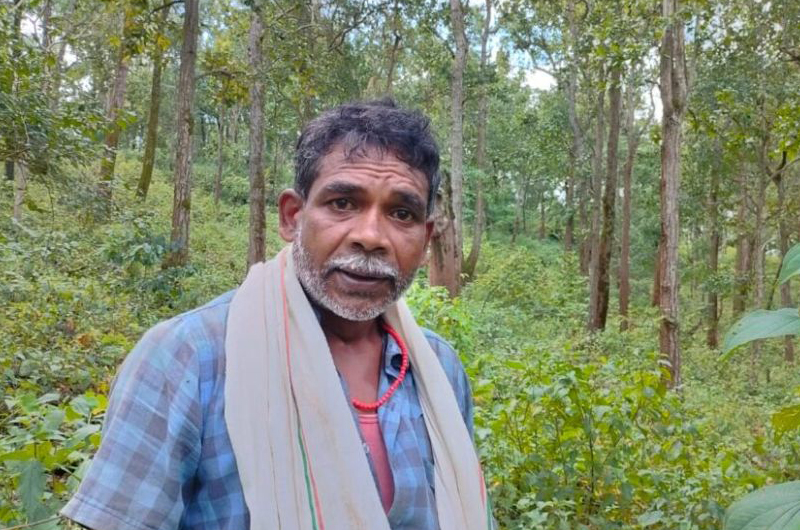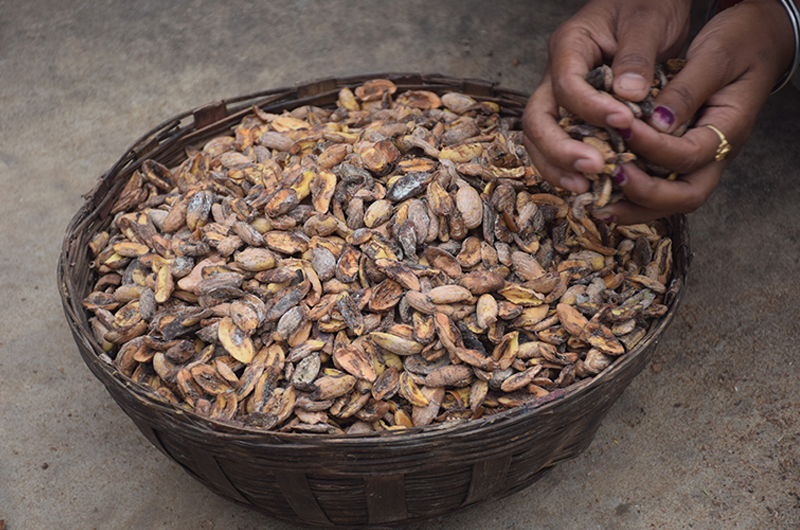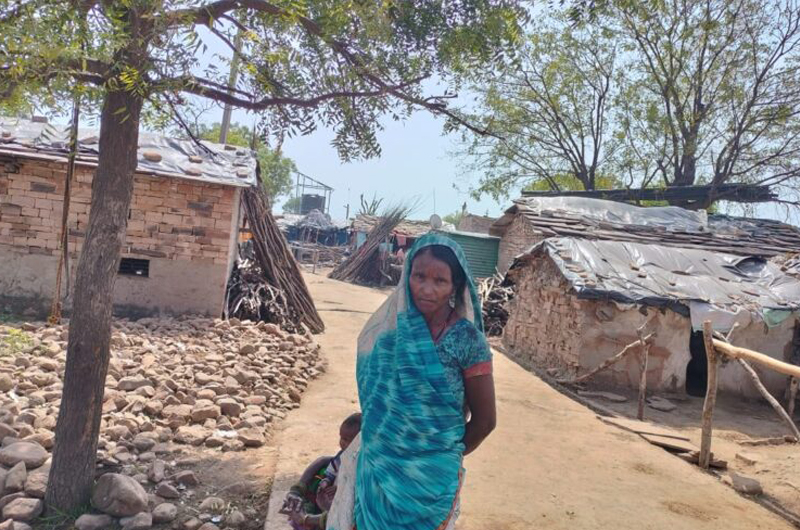Decline in forest produce in Madhya Pradesh is impacting the livelihood of forest dwellers and tribal communities, who collect and trade in medicinal plants. Reports suggest that the increase in demand of herbs and medicinal plants and their extraction in an unsustainable manner, have amplified the pressure on the forests. Climate change also impacts plant phenology or the lifecycle of plants. However, it is important to monitor the long-term impact of climate change on trees and vegetation, scientists say. This article is by Satish Malviya
“It feels good to celebrate festivals only when there is money in hand. But now…,” said Guddi Bai. It was Raksha Bandhan (a popular and traditional Hindu annual rite or ceremony). A resident of the Sahariya tribal settlement in Moravan, a village adjacent to the Kuno National Park in Madhya Pradesh, Guddi Bai was sitting with other residents from the settlement, to discuss something serious. “Now, there is not enough forest produce to collect and sell,” she said. Bai and others gathered there were a part of the ‘forest produce’ group who had not earned any significant income in the past one year. “There is nothing much left in the forest,” said Bai, showing the receipt of the forest produce sold a year ago.
Dilip Adivasi, head of the forest produce group in Moravan, said, “There is a serious dearth of forest produce. There are fewer gooseberries (amla) than before. There is a demand for herbs like shatavari (asparagus), safed museli (white gold), gudmar (gymnema) and pamar in the market, but the supply is an issue.” To understand the status of decline in forest produce, Mongabay-India spoke to collectors in a dozen tribal villages in and around the Kuno National Park, including Khohri, Madkheda, Kakra, Tiktoli and Karai.
“We are barely able to earn anything now. We do not have any land for farming. Earlier, for three to four months in a year, we would earn a living by collecting herbs from the forests and selling them. In the remaining months, we would migrate for labour,” said Rajkishore from Kakra Village. The livelihood of the Sahariya Tribes is dependent on forest produce. A Sahariya family used to earn Rs 20,000 to Rs 30,000 each year from forest produce, according to Rajkishore. Brajesh Gupta, who has been trading herbs and other forest produce for nearly 50 years in Pohari town near Kuno, believes that he will have to close his business in the next three or four years. “The medicinal plant trade in Pohari, Karahal and Shivpuri areas has reduced by 90 per cent,” Gupta shared.

Research indicates shortage of forest produce
The State Environment Department’s report, Climate Change Vulnerability Assessment for Madhya Pradesh, reveals that the eastern, central and western districts in the state are lagging behind in terms of net primary productivity (NPP). These districts include areas such as Gwalior, Bhind, Morena, Datia and Shivpuri. NPP is considered a benchmark of biomass productivity in forests. An increase in biomass productivity can increase the supply of forest products, including timber, fuel wood and other non-timber forest products (NTFPs). It is estimated that in the coming days, the impact of climate change on vegetation distribution in forests, their life cycle and forest types is going to be apparent.
Sustainable Harvesting Protocol for NTFP Plants, an initiative of Green India Mission, reports that 85 per cent demand for raw materials for the country’s pharmaceutical companies is met through forest produce, which is on the decline. Moreover, the report suggests that the increase in demand of herbs and medicinal plants and their extraction in an unsustainable manner from forests in the last few years, have amplified the pressure on the forests.
Sushil Upadhyay, former member of the National Medicinal Plants Board, who was also an advisor for this report, said, “Due to the huge demand, the medicinal plants obtained from the forests have reduced by 70 to 80 per cent. This has created a crisis for tribal families who depend on forests for livelihood. The amount they were earning the bare minimum; now it is negligible.” “In the last 20 years, forest resources are being exploited resulting in changes in the nature of forests and their ecology. This has impacted people whose livelihood depends on forests,” he added. Upadhyay believes that the reason behind the increasing dependence on forests is the reduction in agricultural land.
Utkarsh Ghate, an ecologist associated with the BAIF Development Research Foundation, who has studied the impact of climate change on the trade of medicinal plants and its effect on the livelihoods in Madhya Pradesh, said that the tree-based forest produce such as tendu leaves, mahua, and amla, as well as medicinal plants help forest dwellers earn a significant income, especially during months when they have no work. Ghate shared that tribal communities are not directly involved in the trade of medicinal plants. They sell their collection to small traders who buy from them at negligible prices and sell at a very high price to drug manufacturing companies in Delhi, Punjab and Haryana. “These traders and drug manufacturers are neither bothered about the biodiversity of the forests, nor the livelihood of the forest dwellers. Now, even farmers who own lands have started cultivating medicinal plants, which has further impacted the forest dwellers,” said Ghate.

Sitting in the kitchen of a damp mud house in the Shilpidi, a village in the Baiga Chakk area of Dindori District, is Dasmibai Baiga Vaidya. Her father and father-in-law passed on the knowledge of medicines to her. “We do not sell medicinal plants in the market but use them to treat patients who come from far away with a range of illnesses and give us cash, paddy and wheat in return for treatment,” she said. She highlighted the steady decline in herbs saying, “Earlier, they were easily found in the forest adjacent to the village, but now it has become difficult to find them”. Vaidya Arjun Borkar who lives in the nearby Tantar Village agreed with Dasmibai Baiga and said, “Earlier, the forests were denser, so I used to get all the herbs I needed in the forests near the village. Now, I spend 30 to 40 days in the forest. We have to walk for several kilometres.”
The Bharia Tribals living in Patalkot are also impacted by the decrease in herbs and other forest produce due to the change in weather. Shyamlal Bharti lives in Rathedh Village and belongs to the Bharia Tribal Community whose ancestral occupation is to sell medicinal plants. “Once, Patalkot was considered a treasure trove of herbs, but now not many herbs are available in the forest,” he said, adding that prolonged summers have impacted the production of herbs. “This time, the mahua season was also very short. Chironji is also not available every year,” he said.
Need for long-term research to understand climate change impacts
Rajeev Chaturvedi, the co-chair of the Forest Ecosystem Group of the International Union for Conservation of Nature (IUCN), who studies climate change events, explained, “The biggest and the foremost impact of climate change is seen on the plant phenology or the life cycle of plants. A plant’s flowering, pollination, fruit bearing, everything depends on phenology.”

“Due to climate change in India, the temperature has increased by 0.7 degrees Celsius. Along with this, there has been a dramatic change in the rainfall pattern. Sometimes, it rains too much all at once, sometimes monsoon arrives late and recedes before time. The incidents of drought are also increasing. These extreme weather events are having an impact on the vegetation and trees in the forests.” Chaturvedi added. He also highlighted the link between forest fires and forest produce. “When the moisture in forest reduces by 30-40 per cent, the instances of forest fire increase and it spreads wildly. Fire reduces forest produce.”
Commenting on the lack of long-term data, Avinash Jain, a scientist at the Tropical Forest Research Institute, Jabalpur, said, “From the scientific point of view, it is difficult to say immediately what effect climate change is having on the forests of Madhya Pradesh. For this, we need to conduct long-term research. We are in the early stages of monitoring climate change in Madhya Pradesh. For this, a 10-hectare Permanent Reserve Monitoring Plot was established in the Kanha National Park two years ago, to monitor the long-term impact of climate change on trees and vegetation,” said Jain.
(Courtesy: Mongabay India/ india.mongabay.com)



 from Webdoux
from Webdoux